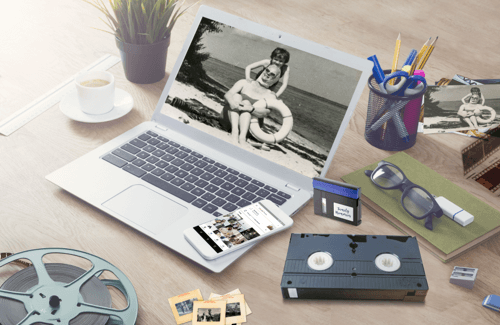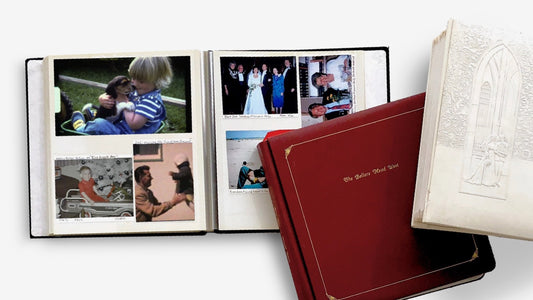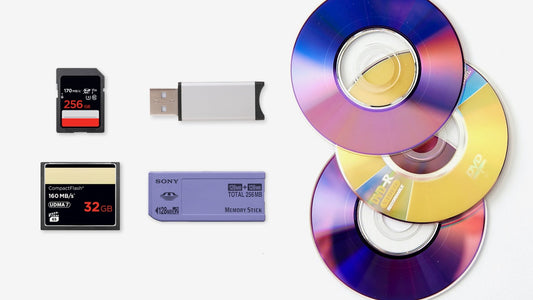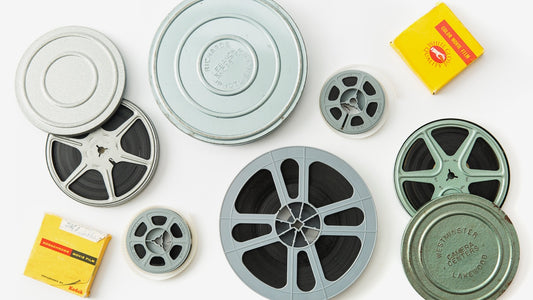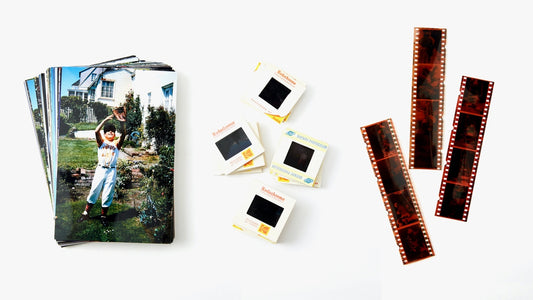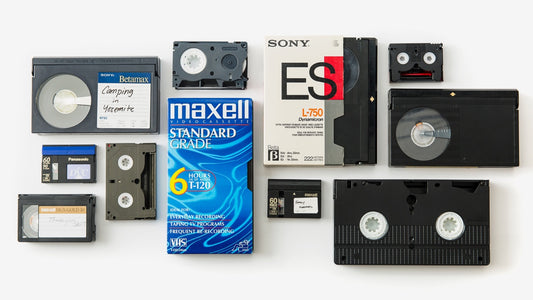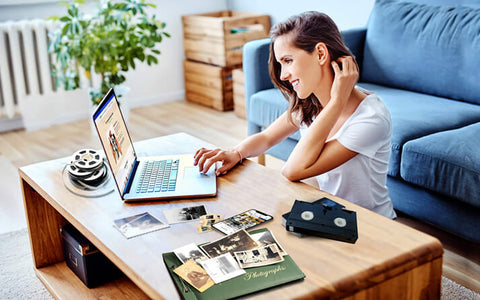Finding a box of your family’s old home movies feels like discovering a time capsule. Inside those little reels are priceless moments: your parents’ wedding, your first steps, holidays with grandparents who are no longer with us. But how do you bring those silent, flickering images back into your life? The answer is simpler than you might think. You can create DVDs from old films, transforming them into something you can easily watch and share. This article is your complete guide to the process, helping you understand your film formats, weigh your options for conversion, and finally enjoy those cherished memories with your family today.
Key Takeaways
- Digitize to Stop the Clock: Your physical films are actively breaking down over time. Converting them to a digital format is the only way to permanently stop this decay, preserving the colors and details of your memories exactly as they are today.
- Professional Transfer is the Safest Choice: While a DIY project is possible, it requires a lot of time and risks damaging your irreplaceable films with old equipment. A professional service guarantees the highest quality results and handles your memories with the expert care they deserve.
- Create a Simple Backup Plan: To truly protect your newly digitized memories for the future, store them in more than one place. A great strategy is to keep one copy on a physical format, like a USB drive, and another in a secure cloud account.
Why Should You Convert Old Films to DVDs?
Those dusty boxes of film reels in your attic hold more than just images; they hold stories, laughter, and moments that define your family's history. But as time passes, those physical films are at risk. Converting them to a digital format like a DVD is the best way to protect and enjoy them for years to come. It’s about making sure those memories are not only safe but also accessible for everyone to enjoy, bringing them out of the closet and back into your life.
Preserve Your Family Memories
Think of your old films as irreplaceable treasures. The problem is, the physical material they're made of is slowly breaking down. Every time you handle them, and even when they’re just sitting in storage, they are aging. Digitizing them is like creating a perfect, timeless snapshot. Once your movies are digital, they won't get worse over time. A professional film transfer creates a high-quality digital copy that captures the footage exactly as it is today, stopping any further degradation. This means your family’s legacy—from your parents' wedding to your first steps—is safely preserved for your children and grandchildren to experience.
Protect Films from Fading
Old tapes and films don't last forever. The chemical compounds that create the images on 8mm and Super 8 film are inherently unstable. Over the years, you might notice the colors begin to fade and shift, taking on a reddish or purplish hue. The film itself can become brittle, making it prone to snapping inside a projector. Humidity and improper storage can speed up this process, leading to mold or other damage that can erase your memories completely. Converting your films to DVD is the only way to halt this natural decay and protect the vibrant, true-to-life colors and details of your original recordings before they are lost for good.
Share and Watch Your Movies with Ease
Let’s be honest, when was the last time you set up a film projector? Having your memories in a digital format makes them incredibly easy to watch and share with family and friends. Instead of digging out old equipment, you can simply play a DVD or access a digital file on your computer. Once your films are digitized, you can easily make copies for your siblings, upload clips for a family reunion slideshow, or share them online with relatives across the country. It transforms your memories from something stored in a box to a living part of your family's daily life, ready to be enjoyed at a moment's notice. This is how you bring your family history into the present.
Identify Your Old Film Formats
Before you can bring your family’s cinematic history into the present, you first need to know what you’re working with. Tucked away in those canisters are likely decades of memories captured on film reels. Figuring out the specific format might seem a little intimidating, but it’s actually pretty straightforward once you know what to look for. You don’t need to be a film historian to sort through your collection.
Most home movies from the mid-20th century were shot on one of three common formats. By checking a few simple details, like the size of the reel and the little holes along the edge of the film, you can easily identify what you have. This step is key to understanding the best way to preserve these irreplaceable moments. Let’s walk through how to identify your film so you can get one step closer to enjoying those memories again.
A Guide to Common Film Types
If you’ve found a box of old home movies, you’re most likely looking at 8mm, Super 8, or 16mm film. These were the go-to formats for amateur filmmakers for decades. 16mm film came first and was often used by serious hobbyists due to its higher quality and cost. Then came 8mm film (also called Regular 8), which made home movies more accessible to the average family. Finally, Super 8 arrived in the mid-60s with an easy-to-use cartridge system that made filming even simpler. The good news is that no matter which format your memories are on, a professional film transfer can convert them into durable digital files you can watch and share today.
How to Tell Which Format You Have
You can easily tell these formats apart by looking at the film itself. Start with the sprocket holes—the small perforations running along the edge. Regular 8mm film has rectangular sprocket holes that are located right next to the dividing line between each frame. Super 8 film has much smaller, almost square-shaped sprocket holes that are centered on the frame line. 16mm film is the largest of the three and is about twice as wide as 8mm film. It can have sprocket holes on one or both sides of the film strip. The size of the center hole on the reel itself is also a good clue: Super 8 reels have a larger center hole than Regular 8mm reels.
How to Store Your Films Properly
Old film is delicate and can degrade over time, even when stored carefully. The best way to keep your films safe for the short term is to store them in a cool, dark, and dry place with low humidity. Avoid attics and basements where temperature and moisture levels can fluctuate dramatically, which can cause the film to become brittle or grow mold. While proper storage can slow down deterioration, it can’t stop it completely. The only permanent way to protect your footage from fading, warping, and decay is to digitize your film. Creating a digital copy freezes your memories in time, ensuring they won’t fade any further and can be enjoyed for generations to come.
How Professional Film Transfer Works
Handing over your family’s irreplaceable films can feel like a big step, but professional services are designed to handle these memories with the utmost care. When you opt for a professional transfer, you’re not just getting a conversion; you’re getting peace of mind. Experts use specialized equipment to capture the best possible quality from your old reels, ensuring your home movies look clear and vibrant for years to come. It’s a straightforward process that takes the technical guesswork off your plate.
The YesVideo Transfer Process
Our goal is to make preserving your memories simple and secure. The process starts when you send us your old media. Once your order arrives at our US-based facility, every single tape, reel, and photo is carefully tracked and processed by hand. We specialize in film transfer and will convert your movies to your choice of DVD, a custom USB, or a digital copy in the cloud. This ensures your cherished moments are not only preserved but also made accessible in modern formats that are easy to watch and share with the whole family.
What to Look for in a Quality Service
When choosing a transfer service, it’s important to find one that can handle various formats and deliver high-quality results. A reliable company will ensure your video content is preserved accurately, allowing you to enjoy those precious home movies for years to come. Look for a service with a long history of happy customers and transparent tracking, so you always know where your memories are. Whether you’re converting film reels or need a complete photo transfer, experience and care are what matter most.
How Long Does It Take?
Patience is key when preserving precious memories, and a quality transfer takes time. Our video transfer service converts all videotape formats—from VHS and Betamax to MiniDV and Hi-8—to digital within about 3-4 weeks from the time we receive your order. This timeframe allows our technicians to give each order the individual attention it deserves, ensuring a high-quality, handcrafted result. We’ll keep you updated with email notifications throughout the process, so you’re never left wondering about the status of your films.
Explore Custom Features and Add-ons
A great transfer service offers options to fit your specific needs. You can tailor your order by choosing the format that works best for you, whether that’s a physical DVD or a more versatile digital file. For example, you can select a specific format or digitize all types of film reels to start your order. Many services, including ours, also offer add-ons like extra copies of DVDs for family members or a USB drive for easy storage and sharing. These custom features help you create the perfect digital archive for your family’s history.
How to Convert Film to DVD Yourself
Taking on a DIY project to preserve your family memories can be a rewarding experience. It gives you a hands-on role in bringing your family’s history back to life. While converting old films to DVD yourself is possible, it requires the right equipment, a bit of technical know-how, and a good amount of patience. You’re essentially setting up a mini-production studio at home to capture your films frame by frame.
The process involves playing your old movies on their original equipment and using a special device to record them onto your computer. From there, you can burn the digital files onto a DVD. It’s important to remember that you’ll be working with delicate, aging media, so handling everything with care is key. If your films are especially precious or fragile, a professional film transfer service is often the safest route. But if you're feeling adventurous and have the time, here’s what you need to know to get started.
Gather Your Equipment and Software
First, you’ll need to round up your supplies. The most important piece of equipment is a working player for your film format, like an 8mm or Super 8 projector. Make sure it’s clean and running smoothly, as old machines can sometimes damage brittle film. You will also need a video capture device, which acts as a bridge between your old projector and your modern computer. These devices typically connect to your player with RCA cables (the red, white, and yellow ones) and plug into your computer’s USB port. Finally, you’ll need software like Open Broadcaster Software (OBS) to record the video feed onto your computer.
Follow This Step-by-Step Guide
Once you have your gear, you can start the transfer process. First, connect your projector or VCR to the video capture device using the RCA cables. Then, plug the USB end of the capture device into your computer. Open your recording software and select the capture device as your video source. You should see the feed from your player on your computer screen. Press record in the software, then press play on your projector. The movie will be recorded in real-time, so a 30-minute film will take 30 minutes to capture. After recording, you can use your computer’s DVD burner and software to create your DVD.
What Affects DIY Quality?
The quality of your final DVD depends heavily on a few factors. The most significant is the condition of your original films. Media formats like 8mm film, Super 8, and VHS naturally degrade over time, causing colors to fade and the film itself to become brittle. The quality of your playback equipment also matters. A projector with a flickering bulb or a VCR with a dirty head will produce a lower-quality transfer. Your video capture device plays a role, too; a higher-quality device will generally yield better resolution and more accurate colors. For irreplaceable memories, a professional photo transfer can ensure the best possible quality.
Avoid These Common DIY Pitfalls
When converting films yourself, a few common issues can pop up. The biggest risk is damaging your original media. Old projectors can snag and tear fragile film, so always handle your reels with care and supervise the entire playback process. Another common problem is poor audio or video quality from incorrect connections or low-grade equipment. Double-check that all your cables are plugged in securely. Finally, be prepared for the time commitment. Capturing footage in real-time, editing it, and burning it to a DVD can take many hours, especially if you have a large collection of films to convert.
How to Get the Best Transfer Quality
Getting a clear, watchable digital copy of your old films is the whole point of this project. Whether you decide to digitize them yourself or hand them over to a professional service, a few key steps can make a world of difference in the final quality. Your goal is to create a beautiful digital keepsake that your family can enjoy for years, and paying attention to the details will help you get there.
Prepare Your Films for Transfer
Old tapes and films don't last forever. Formats like 8mm film, Super 8, and VHS were never meant for long-term storage, and their magnetic tape and film stock will eventually break down. Before you begin the transfer process, take some time to inspect your collection. Gently clean the outside of any cassettes or film reels with a soft, dry cloth to remove dust. If you notice any visible damage, like a torn tape, it’s best to let a professional handle the repair. Organizing your films by date or event beforehand will also make the final digital files much easier to sort through. This preparation ensures you’re starting with the best possible version of your memories before you even begin the film transfer.
Professional vs. DIY: A Quality Comparison
Choosing between a professional service and a DIY converter often comes down to your priorities. DIY converters give you complete control over the process and can be a good option if you only have a few tapes and enjoy a hands-on project. However, the quality can be a trade-off. Most home converters essentially re-record your movie in real-time, which can result in a lower-resolution copy. Using a professional service ensures your film is scanned frame-by-frame at its original speed, capturing much more detail. Professionals use commercial-grade equipment that’s specifically designed to handle old, fragile media, giving you a much clearer and more stable final product.
Options for Enhancing Your Film Quality
Digitizing your films is the first step, but you can also improve how they look. Over the years, the color in old films can fade, leaving them with a blue or reddish tint. Professional services often include color correction and other enhancements to make your old films look better, with more vibrant colors and clearer pictures. Special software can also help fix faded colors and repair minor damage. While some editing tools are available for home use, the technology used by a dedicated video transfer service is typically more advanced, giving your memories a welcome refresh and bringing them back to life.
Maintain Your DIY Equipment
If you decide to go the DIY route, be careful, as old or low-quality machines can damage fragile tapes. A VCR that hasn’t been used in years might chew up a precious home movie, so it’s important to test your equipment with a non-essential tape first. When choosing a converter, consider the video quality it produces, its ease of use, and its compatibility with your computer. Also, look at the available editing features and the final output options. Taking the time to find and maintain the right equipment is essential for protecting your films and getting the best possible results at home.
Comparing the Cost: Professional vs. DIY
Deciding whether to digitize your old films yourself or hand them over to a professional often comes down to one thing: cost. But the true cost isn't just about the price tag. It's a balance between your money, your time, and the quality of the final result. Going the professional route means you’re paying for expertise, high-end equipment, and the convenience of having someone else handle the entire delicate process. It’s the peace of mind that comes from knowing your irreplaceable memories are in good hands.
The DIY path, on the other hand, seems more budget-friendly at first. It trades a lower upfront monetary cost for a significant investment of your personal time and effort. You become the technician, the editor, and the quality control specialist. Before you choose, it's important to weigh both sides. Let's break down the numbers and the time commitment for each option. This will help you figure out which approach makes the most sense for your family’s precious films, your schedule, and your budget. We’ll look at the typical costs for professional services, what you’d need to buy for a DIY setup, and how long you can expect each process to take.
How Much Do Professional Services Cost?
When you opt for a professional service, you’re paying for a straightforward, hands-off experience. Prices are often quite reasonable for the convenience you get. For instance, you might see a VHS to DVD transfer service for around $24.96 at a big-box store. Here at YesVideo, we handle every order by hand to ensure your memories are safe. Our video transfer service is designed to give you high-quality digital copies without you having to lift a finger. You simply send us your films, and we take care of the rest, returning your originals along with your new digital versions. It’s a simple way to ensure your memories are preserved correctly.
Breaking Down the Cost of DIY
At first glance, the DIY approach seems like a bargain. The main purchase you’ll need is a video capture card, which can cost as little as $20. However, the hidden costs can add up. First, you need the right equipment to play your old films, like a working VCR or film projector. If you don't already have one, finding one in good condition can be tricky and expensive. You also have to factor in the cost of software and blank DVDs or a hard drive for storage. While the initial investment might be low, the costs can creep up, especially if you run into technical issues that require more gear or time to solve.
Find Package Deals and Discounts
If you decide a professional service is the right fit, you can often find ways to save money. Many companies offer package deals if you have a large collection of films to convert, which can bring the per-tape cost down significantly. It’s also a great idea to keep an eye out for seasonal promotions and sales. Services like Legacybox sometimes run 50% off sales, and you can often find special discounts at places like CVS Photo. A little bit of research before you commit can lead to some great savings, making professional digitization even more affordable and a clear winner for your budget.
Consider the Time Investment
Time is a huge factor in the professional vs. DIY debate. When you send your films to a professional, the process is fairly quick and requires very little of your time. Most services, including YesVideo’s film transfer, typically take about three to four weeks from the time they receive your order. In contrast, a DIY project is a major time commitment. You’ll need to set up the equipment, troubleshoot any technical glitches, and then sit through the entire transfer process for every single film. If you have a large collection, this could easily turn into a project that spans several weekends or even months of your free time.
Choose Your Digital Format and Storage
Once your precious films are digitized, you’ve won half the battle against time. The next step is just as important: choosing how to store and enjoy them for years to come. Think of it less as a technical decision and more as creating a personal library of your family’s history. The right format depends on how you want to watch, share, and preserve your movies.
With a professional film transfer, you’ll typically have a few options, including DVDs, USB drives, and a digital copy you can access online. Each has its own perks, and the best strategy often involves using a combination of them. This ensures your memories are not only easy to access but also securely backed up. Let’s walk through the most common choices so you can build a storage plan that works for your family.
Why Choose DVDs?
In an age of streaming and cloud storage, a physical DVD can feel wonderfully simple and personal. DVDs are a fantastic, tangible way to hold onto your memories. They’re easy to wrap up as a heartfelt gift for parents or grandparents and perfect for a family movie night—just pop it into a player and press play. You don’t need a fancy computer or a fast internet connection to enjoy them. A DVD provides a durable, physical copy that isn’t dependent on a subscription or a password, making it a reliable and straightforward choice for long-term preservation.
Make Copies for the Whole Family
One of the best ways to protect your family’s history is to share it. As senior archivist Dan Erdman suggests, you should send copies of your digitized videos to as many family members as possible. Think of it as a built-in safety net. If your copies are ever lost or damaged in a fire or flood, your sibling or cousin will have another one safe and sound. Gifting a DVD or a USB drive to loved ones isn't just a thoughtful gesture; it's a smart preservation strategy that ensures your family's stories will survive, no matter what.
Save Your Memories to the Cloud
For ultimate convenience and accessibility, the cloud is your best friend. When your memories are stored online, you can watch them from anywhere, on any device—your phone, tablet, or smart TV. This makes sharing a favorite clip on social media or sending a link to a relative across the country incredibly simple. Most transfer services, including YesVideo, provide a free digital copy with your order, giving you instant access to your movies in a private online account. This is the easiest way to keep your entire collection at your fingertips.
Create a Smart Backup Plan
The single best thing about digital files is that, unlike physical film, they don't degrade over time. Your movie will look just as good in 50 years as it does today, as long as it’s properly saved. The smartest approach is to create a multi-layered backup plan. Don't rely on just one format. A great rule of thumb is to keep your memories in three places: on your computer, on a physical format like a DVD or USB drive, and in the cloud (like the Digital Copy from your digital media transfer or a service like Google Photos). This strategy ensures that no single event can erase your precious memories.
Organize and Share Your Digitized Memories
Once your home movies are digitized, the fun really begins. You’ve successfully preserved them from the wear and tear of time, and now you have a versatile digital collection that’s ready to be organized, watched, and shared with the people you love most. This is your chance to bring those memories back into your family’s life. Let’s walk through how to make the most of your new digital keepsakes, from creating a tidy library to sharing moments with relatives near and far.
Tips for Organizing Your Digital Movies
One of the best parts about having digital files is that they won’t degrade over time. To make them easy to find, it’s a good idea to create a simple organization system. Start by creating folders on your computer or cloud storage account. You can name them by year, by event (like "Summer Vacation 1992" or "Grandma's 70th Birthday"), or by the family members featured. Inside these folders, give each video a descriptive name. You can also add tags or keywords like "Christmas," "beach," or "wedding" to make your files searchable, so you can find that one specific clip in seconds.
How to Watch Your New Digital Collection
Gone are the days of dusting off an old projector. With your new digital collection, watching your memories is as simple as pressing play. When you use a film transfer service, you can typically choose how you want to receive your files. You might get a Digital Copy to stream from the cloud, a USB drive you can plug directly into your TV or computer, or a classic DVD for your player. This flexibility means you can watch your family’s history unfold on your smart TV, gather around a laptop, or even view clips on your phone, bringing these moments into your modern life.
Share Your Memories with Loved Ones
Sharing your digitized memories is a wonderful way to reconnect with family. You can easily send copies to everyone who wants one, ensuring the memories live on across generations. Consider creating a shared online album where family members can view and download their favorite clips. You could even edit together a highlight reel of the best moments and set it to music for a special occasion. Sharing these videos can spark conversations, bring back fond stories, and help younger family members feel connected to their heritage in a way that old, inaccessible film reels never could.
Keep Your Digital Memories Safe for Years to Come
While your original tapes and films were vulnerable to fading and damage, your digital files need a different kind of protection. To keep them safe for the long haul, it’s smart to have more than one copy. A good rule of thumb is to keep your files in at least two different places, like on your computer’s hard drive and on an external USB drive. For extra security, you can also upload them to a cloud storage service. This creates an off-site backup, so even if something happens to your computer, your precious memories are still secure. This simple backup plan ensures your family’s legacy is protected for generations.
Related Articles
- 8mm to DVD: Top Conversion Services & DIY Guide – YesVideo
- Convert VCR to DVD: Your Step-by-Step Guide – YesVideo
- Convert VHS to DVD: Save Your Movies Before They Fade [2025 Guide] – YesVideo
- Where Can I Convert VHS to DVD? 7 Top Services – YesVideo
Frequently Asked Questions
What happens to my original film reels after you convert them? We always return your original films to you along with your new digital copies. We understand that these are irreplaceable family treasures, which is why every reel is processed by hand with great care at our facility. Your originals will be sent back in the same condition we received them, so you can store them safely while enjoying the new, accessible digital versions.
My films look pretty faded and old. Is it even worth converting them? Yes, it absolutely is. While digitization can't reverse severe damage, the process itself stops any further fading or decay in its tracks. Professional services often include color correction that can help restore some of the original vibrancy and clarity to your footage. You might be surprised at how much better your movies look once they've been properly scanned and enhanced.
I have a mix of film reels, VHS tapes, and photo albums. Can I send them all in one order? Of course. We know that family memories are rarely stored in just one format. You can include all your different types of media—from 8mm film and Betamax tapes to photo albums and slides—in a single order. This simplifies the process, allowing you to preserve your entire family archive at once without juggling multiple shipments or services.
Is a DVD the best format, or should I get a digital copy? The best format really depends on how you plan to use your movies. DVDs are fantastic for giving as gifts and are simple to play for family movie nights. A digital copy, which you can get on a USB or through a cloud link, offers more flexibility for editing, sharing online, and watching on various devices like your phone or tablet. Many people choose to get both to have a physical backup and the convenience of a digital file.
How can I be sure my irreplaceable films won't get lost during the process? We completely understand this concern, and it’s why we’ve built a process centered on security. We recommend you use a trackable shipping service to send your order to us. Once your films arrive at our facility, we track them by hand at every step of the way and send you email updates throughout the entire transfer process. This gives you peace of mind knowing exactly where your memories are from start to finish.





